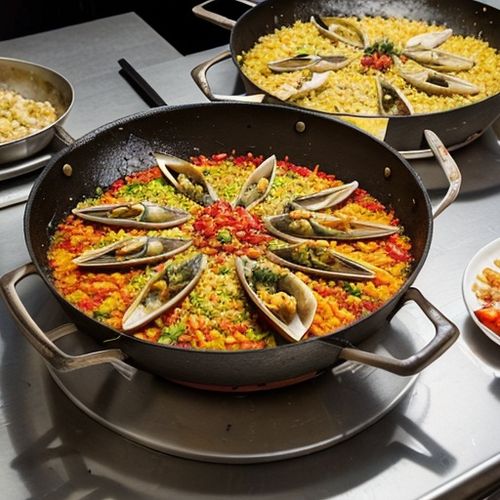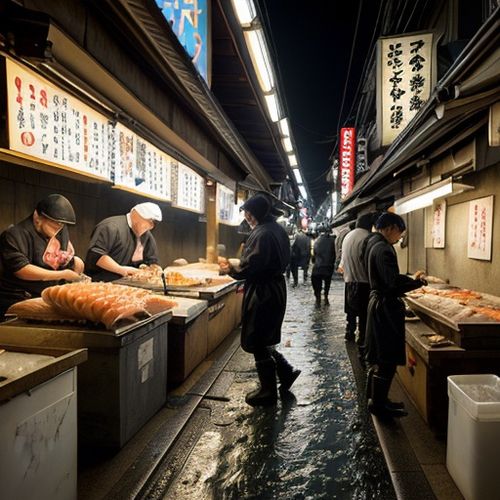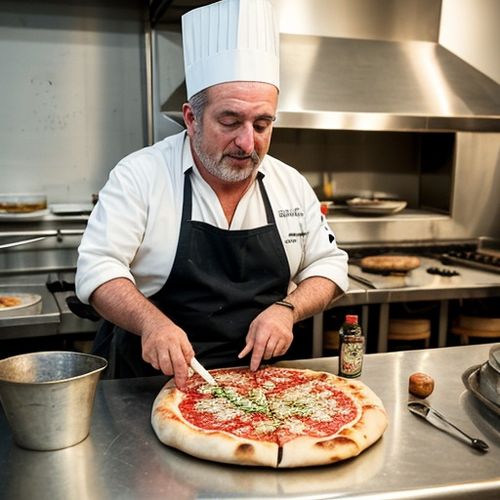The predawn darkness of Tokyo's Tsukiji fish market hums with a peculiar energy – a symphony of rubber boots slapping against wet concrete, the rhythmic scraping of ice from fish bellies, and the staccato calls of auctioneers conducting transactions at speeds incomprehensible to outsiders. This is where my journey as a sushi apprentice begins, not with the delicate artistry one might imagine, but with the visceral reality of the seafood trade that powers Japan's most iconic culinary tradition.
Arriving at 4:30 AM, I'm immediately struck by the market's organized chaos. My instructor, a retired sushi chef turned cultural ambassador named Tanaka-san, hands me a pair of waders without ceremony. "Real sushi begins here," he says, gesturing toward the fluorescent-lit alleys where wholesalers hawk everything from thumb-sized sardines to tuna carcasses the size of small cars. The smell – that briny, metallic tang of fresh seafood mixed with the mineral sharpness of crushed ice – lodges itself in my sinuses, a sensory anchor to the experience.
Tanaka-san leads me through a crash course in fish assessment, his hands moving with practiced efficiency as he demonstrates how to check a sea bream's clarity of eye, the firmness of a squid's mantle, the iridescence of mackerel skin. "Westerners think sushi is about rice," he murmurs while pressing his thumb against a salmon belly, "but we spend our first years learning to judge fish like librarians judge books." The analogy sticks with me as we select ingredients for the day – two types of tuna (lean akami and fatty otoro), a still-fluttering live shrimp, and a bundle of crisp nori that crackles like autumn leaves when bent.
The transition from market to kitchen reveals the first of many cultural disconnects in my understanding of sushi. Instead of heading straight to a pristine restaurant kitchen, we stop at a 70-year-old rice wholesaler where Tanaka-san argues passionately about moisture content and harvest dates. Watching him inspect individual grains by rolling them between his fingers, I begin to grasp the obsessive attention to detail that separates casual enjoyment from professional dedication. The rice cooker in our borrowed kitchen isn't some high-tech appliance but a heavy cast-iron pot that requires constant heat adjustment – "like a temperamental lover," jokes Tanaka-san as he demonstrates the finger-width water measurement technique passed down through generations.
Preparing the shari (sushi rice) becomes an unexpected baptism by fire. The vinegar mixture must be incorporated at precisely 104°F while fanning the rice to achieve the perfect gloss without mushiness. My first attempt produces something resembling congee, drawing a pained smile from Tanaka-san. "In Edo period," he says while salvaging the batch with practiced hands, "apprentices would be struck with a rice paddle for such offense." The threat feels only half in jest as I notice the calluses on his palms from decades of this work.
Knife skills training proves equally humbling. The legendary yanagiba knife feels alien in my Western-trained grip, its single-bevel edge requiring a completely different cutting philosophy. Tanaka-san demonstrates the signature pull-cut technique on our tuna – not the sawing motion I've used for years, but a single fluid draw of the blade that leaves the flesh's cellular structure intact. My initial attempts produce ragged slices that would disgrace a supermarket deli counter. "The knife must become part of your arm," he advises, adjusting my wrist angle with fingers that somehow manage to be both gentle and unyielding. Three hours and twelve failed cuts later, I finally produce a presentable slice of akami, its deep red cross-section gleaming like polished gemstone.
As lunch service approaches, the pace shifts from methodical to frenetic. Tanaka-san transforms before my eyes – the patient teacher replaced by a whirlwind of precision as he demonstrates nigiri formation. His hands move with the unconscious grace of a concert pianist, each motion pared down to its essential components: the exact pressure needed to shape the rice without compacting it, the single swipe of wasabi, the artful draping of fish that appears to melt onto the shari. My attempts look like children's play-dough creations by comparison, either collapsing into loose grains or emerging as dense rice bullets that would sit heavily in the stomach.
The most profound lesson comes not from technique but philosophy. Between customers, Tanaka-san explains the concept of "shun" – the precise moment when an ingredient reaches peak perfection. "We don't force our will upon the fish," he says, adjusting a slice of flounder to follow its natural grain. "We become translators, helping it express its best self." This revelation colors everything that follows, from how I score the squid to enhance its texture to why we briefly age some fish while serving others at ultimate freshness.
By day's end, every muscle in my body protests – feet swollen from hours of stationary standing, forearms burning from unfamiliar knife grips, fingertips pruned from constant contact with vinegared rice. Yet as I sample my few presentable creations alongside Tanaka-san's masterpieces, the gap between them feels less discouraging than inspiring. The perfect bite of his otoro nigiri – the way the fish dissolves like savory butter while the rice maintains its structure – becomes not just a taste but a memory, a standard to chase.
Walking back through Tsukiji's now-quiet alleys as vendors scrub down their stalls, I realize the true lesson of this apprenticeship. Sushi mastery isn't about replicating techniques but developing a relationship with ingredients that borders on reverence. The early wake-up calls, the physical demands, the years of repetition – these aren't hurdles to the craft but essential passages in learning to listen to what the seafood wants to become. My single day of blunders and small triumphs has given me not just skills to practice, but a new lens through which to appreciate every piece of sushi I'll ever encounter again.

By Eric Ward/Apr 11, 2025

By Laura Wilson/Apr 11, 2025

By Jessica Lee/Apr 11, 2025

By Christopher Harris/Apr 11, 2025

By Michael Brown/Apr 11, 2025

By Victoria Gonzalez/Apr 11, 2025

By Daniel Scott/Apr 11, 2025

By Natalie Campbell/Apr 11, 2025

By Daniel Scott/Apr 11, 2025

By Joshua Howard/Apr 11, 2025

By Christopher Harris/Apr 11, 2025

By Amanda Phillips/Apr 11, 2025

By Rebecca Stewart/Apr 11, 2025

By Amanda Phillips/Apr 11, 2025

By Megan Clark/Apr 11, 2025

By Olivia Reed/Apr 11, 2025

By Jessica Lee/Apr 11, 2025

By Grace Cox/Apr 11, 2025

By Rebecca Stewart/Apr 11, 2025

By Olivia Reed/Apr 11, 2025